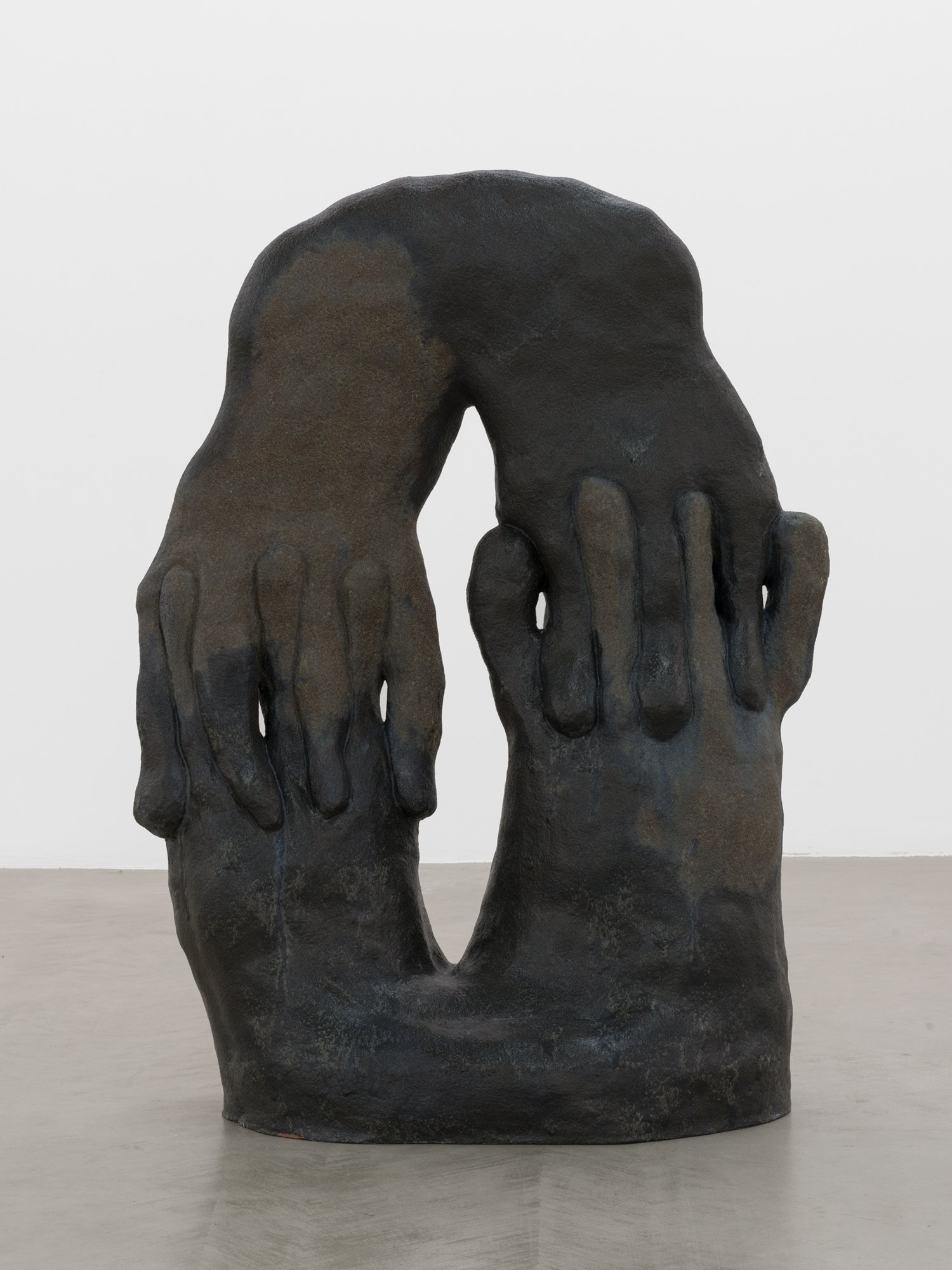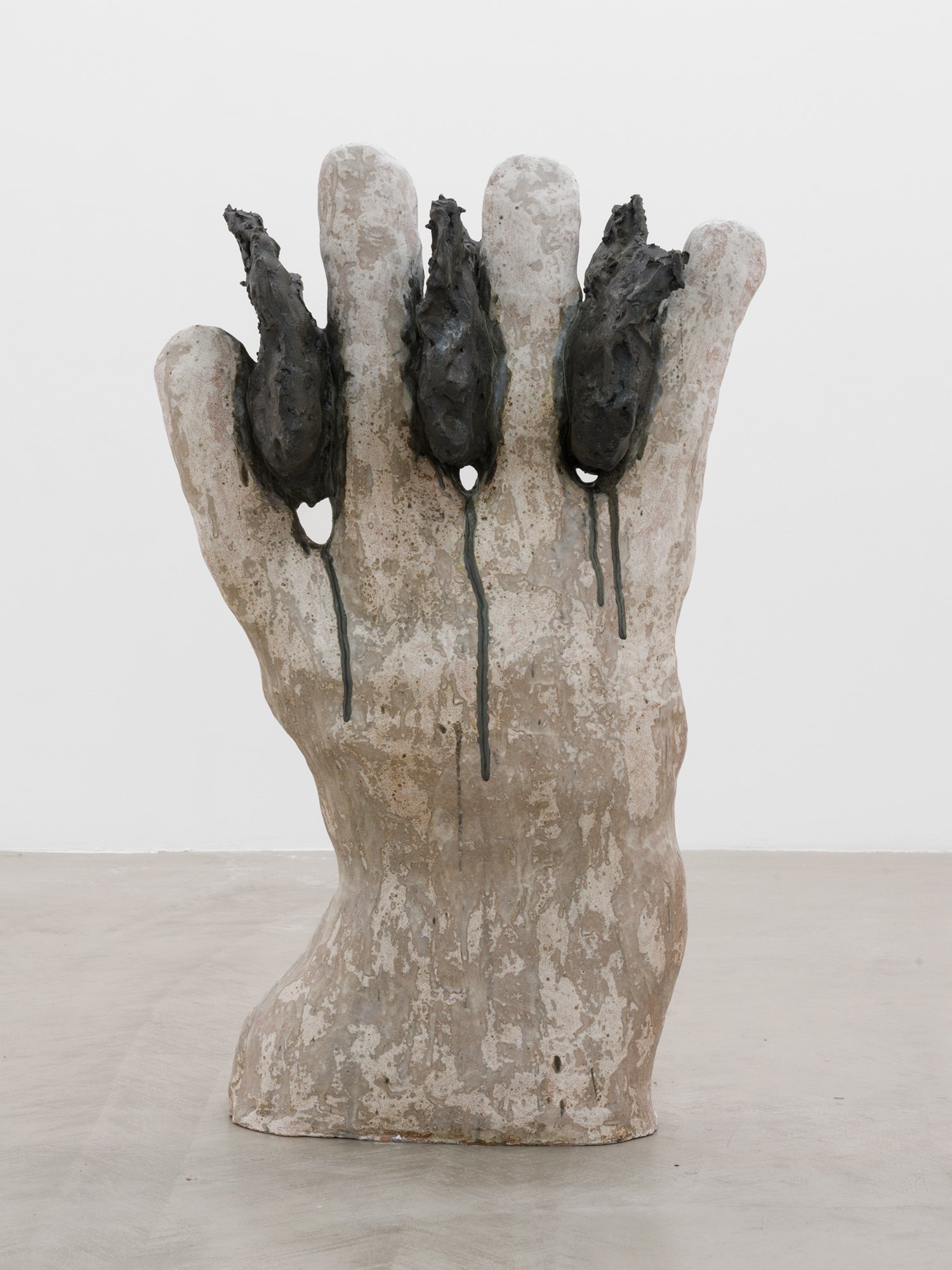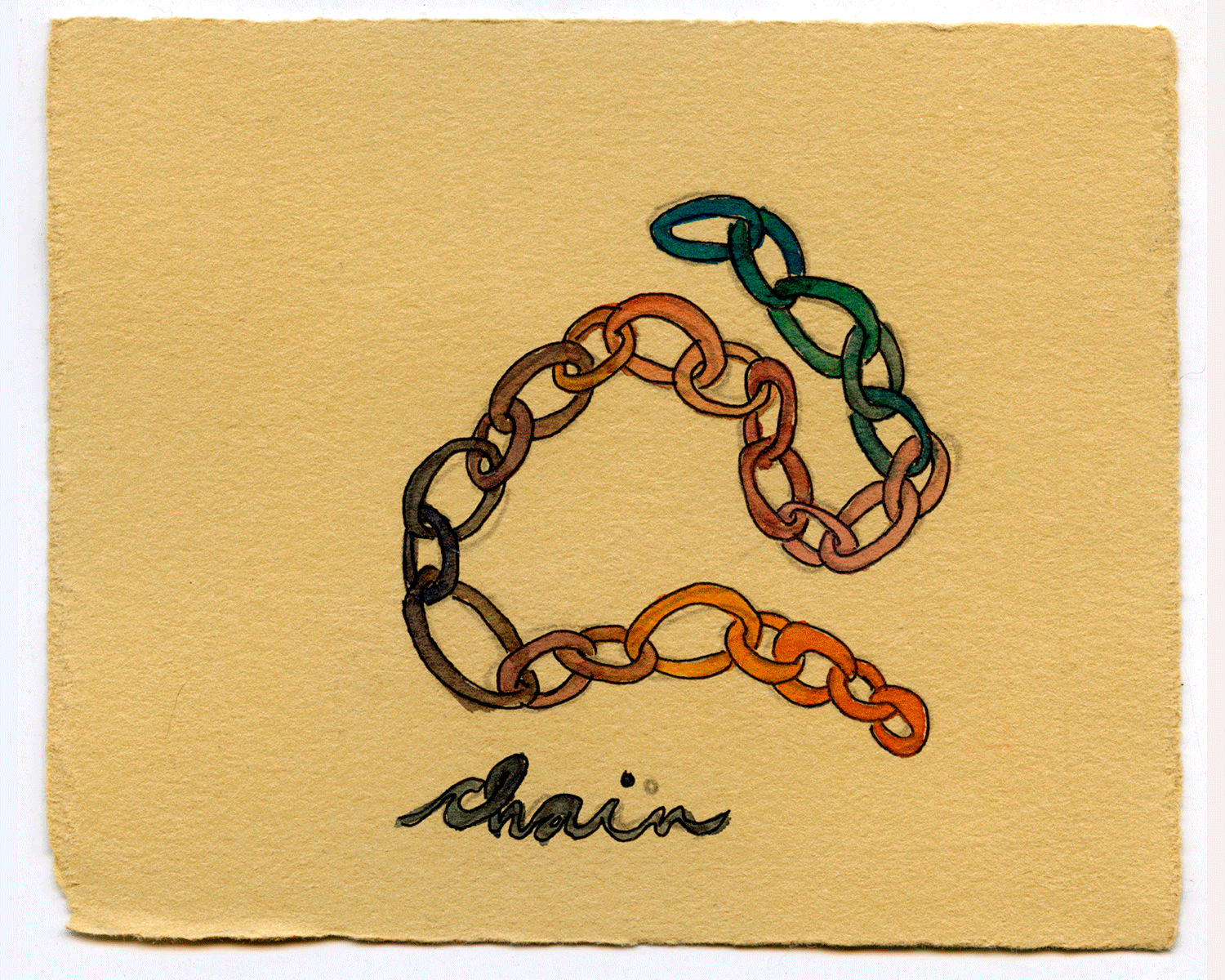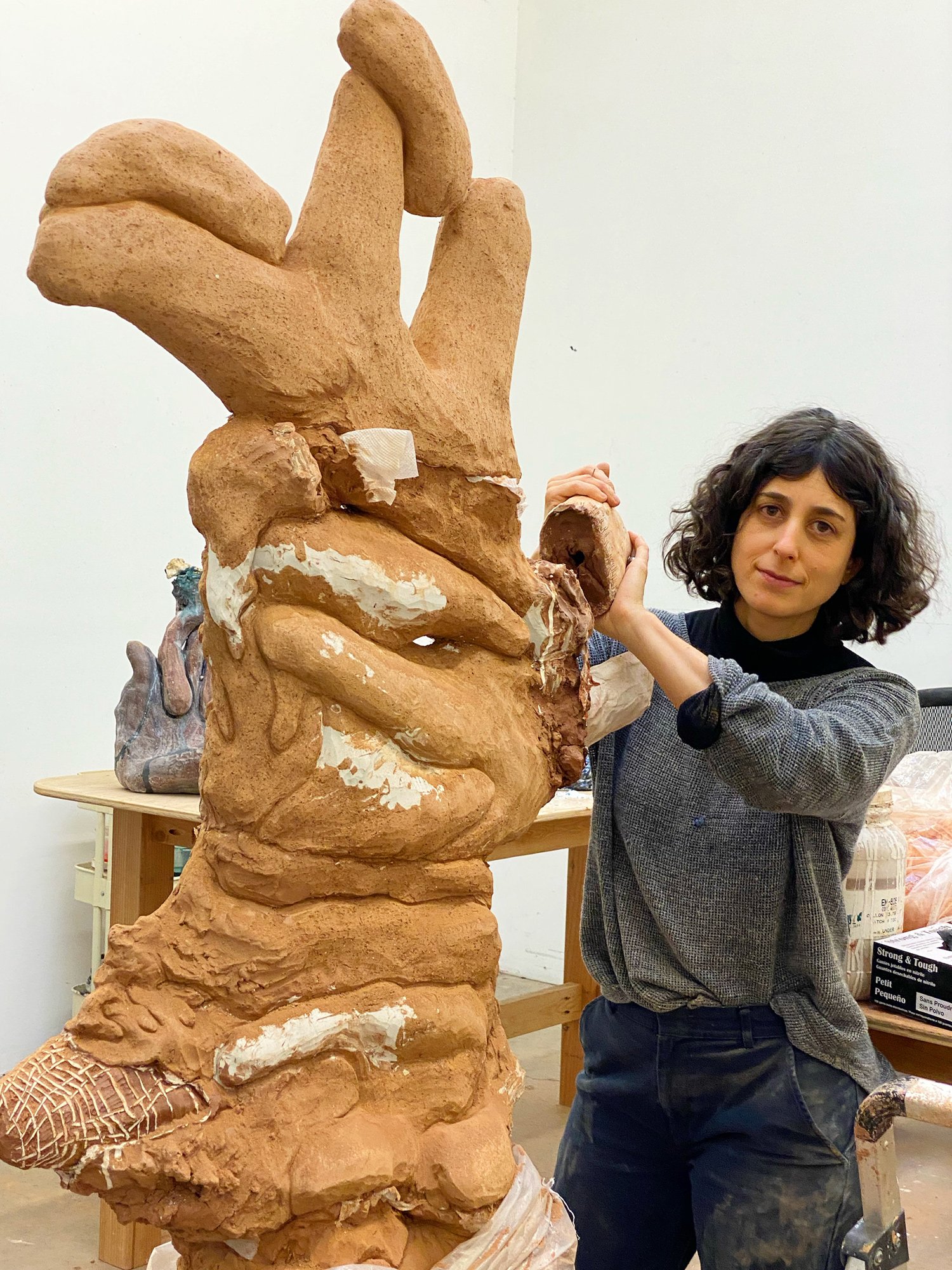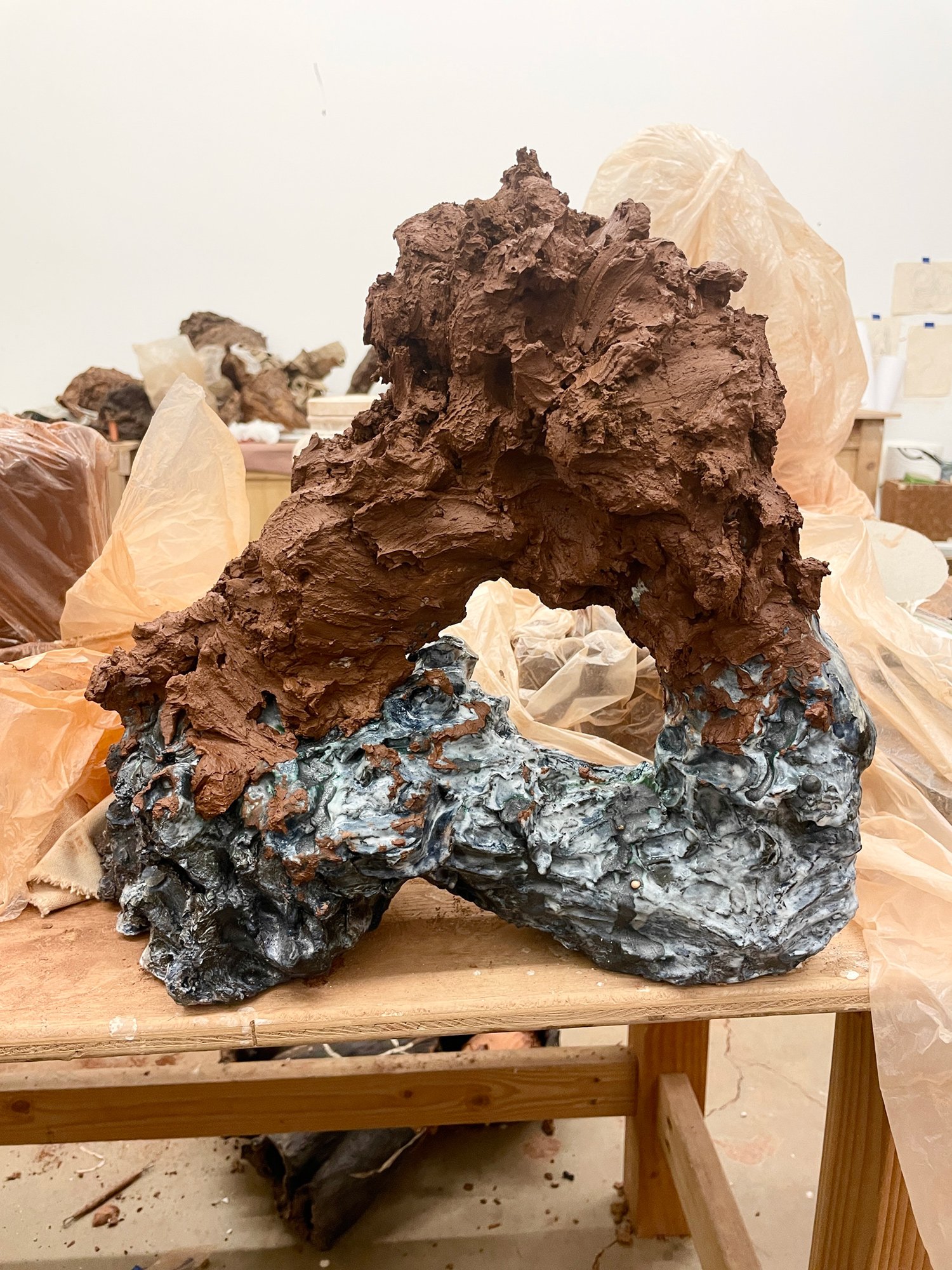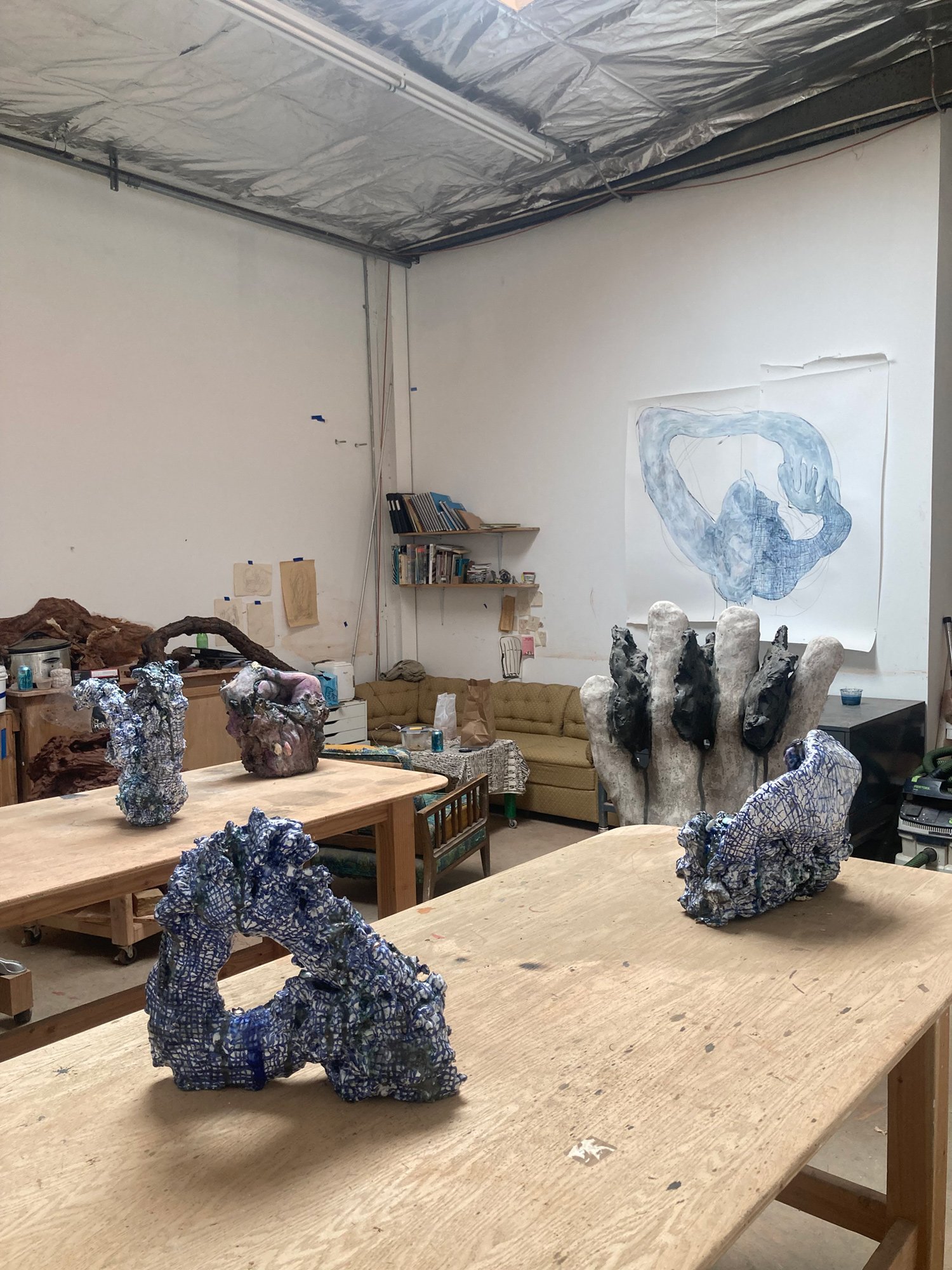
Julia Haft-Candell’s work often reads as anthropomorphic–not so much by taking the shape of the human body (although hands and legs recur), but rather by evoking through physical material a desire to connect, to touch, or to relate disparate parts. Her interest in science fiction lends a distinctly narrative component to her work, which creates the sense that her sculptures are set in motion and part of a larger story. Language features prominently, both directly through the use of text, and indirectly through the use of a lexicon of forms that the artist returns to recurrently.
She works primarily in ceramics, a material that the artist is drawn to for its ostensibly contradictory states: fluid and malleable when wet, and fixed when fired. However, clay’s more transmutable qualities are present in Haft-Candell’s lexicon of forms and patterns, evoking universally recognizable themes such as infinity symbols, combs, hands, and chains. Since 2021, she has expanded her practice to include bronze, which has further enabled her to create a new body of large scale and outdoor sculpture that are in direct conversation with her work in clay, even combining the two materials within a single work at times.
Haft-Candell lives and works in Los Angeles. In 2020, she presented her first solo exhibition in New York with CANDICE MADEY, Carrier Bag of Fiction. Other recent solo exhibitions include Night Gallery, Los Angeles, CA; Parrasch Heijen Gallery, Los Angeles, CA; and group exhibitions at CANDICE MADEY, New York, NY; LA LOUVER, Los Angeles, CA; Inman Gallery, Houston, TX; Grand Central Art Center at California State University, Fullerton CA; the Craft Contemporary, Los Angeles, CA; Interface Gallery, Oakland, CA; Franklin Parrasch Gallery, New York, NY; among others. Her work has been written about in Artforum, Surface Magazine, East of Borneo, The New York Times, and The Los Angeles Times. She received an MFA from California State University Long Beach and BA in Studio Art and International Relations from University of California Davis.
Haft-Candell is the founder of the infinite school, an experimental space for ceramic education outside of the institution.
Reaching Through Blue Grid, 2022
Watercolor, ink, bronze, paper pulp, clay, chalk, marble dust, pigment and binder on linen
22 x 30 inches
Photo by Michael Tyrone Delaney.
—
Image credits: Julia Haft-Candell in her studio. Photo by Hilary Fagadau (banner); Nothing/Everything/Hands/Feelers, 2022, Fired clay, glaze, bronze, jewelry and glass, 17 1/4 x 18 1/2 x 7 1/2 inches. Photo by Michael Tyrone Delaney (middle).

Sculpting in Clay
"Clay can do so many different things, and I feel unlimited in terms of what I can make. I use the material to explore in so many ways that by having this framework, it helps me feel more grounded."
— Julia Haft-Candell in an interview with curator Anna Katz
East of Borneo, January 2022
Combs, 2017
Black clay and underglaze
20 x 17 x 6 inches
Photo by Jeff McLane
Becoming Infinity: Loops, 2017
Ceramic
14 x 13 1/2 x 9 inches
Photo by Jeff McLane
Infinity: Nothing/Everything, 2017
Black clay and underglaze
17 x 21 x 5 1/2 inches
Photo by Jeff McLane
—
Image credits: the infinite, 2017 (installation view), Parrasch Heijnen Gallery, Los Angeles. Photo by Jeff McLane (banner).

Haft-Candell On the Monumental
I look with a critical eye to traditional monuments that tell a patriarchal story of hero and masculinity. I find shared vision in Henry Moore’s monumental bronze bodies, but disagree with his cultural appropriation and subjugation of the female form. Claes Oldenburg’s flaccid soft sculptures of pop imagery start to tell the story of failure and vulnerability that I yearn for. I find the most inspiration in Louise Bourgeois’ takes on the monument as spider mother, the body, and as multiple rather than singular. The Interlocking series would follow in the footsteps of these monumental works, using the permanence of hard metal to juxtapose the softness implied by shape and imprint of hand.
At this moment throughout the world, the idea of monument is being rightly questioned. Histories are told through monuments, stories that often imply a winner and a loser, hero and villain. This binary explanation tells a false story of humanity that leaves many, including myself, feeling alienated. In contrast, ambiguous and complex monuments such as Interlocking (2020) and Denim Chain on Trees (2016) tell a nuanced story, asking questions rather than dictating answers. They proudly display flaws and imperfections, asking the viewer to do so as well.
—
Image credits: Interlocking, 2020 (installation view), Night Gallery, Los Angeles. Photo by Marten Elder (banner); Denim Chain on Trees, 2016, Foam, denim, aqua resin. Photo by Gina Clyne, courtesy of Clockshop (middle); Interlocking Arch, 2019, Ceramic, 52 1/2 x 38 x 19 inches, Swim, 2019, Ceramic, 51 x 32 1/2 x 15 inches. Photos by Ed Mumford (above).

Bronze and the Modernist Tradition
“The paradox of loving modernism but being repelled by the story of the macho modernist hero toiling away in his studio has guided me as I navigate my practice as an artist. The binary values of western culture encouraged me to choose this or that, either be a part of the patriarchal story or do something entirely separate. The bronze works are the result of being influenced by and fighting against modernist sculpture.”
— Julia Haft-Candell
Woven Hand with Teal, 2021
Bronze, 5 1/2 x 6 x 3 1/2 inches
Photo by Mackenzie Goodman
Expanding Green and Ochre, 2021
Bronze
11 3/4 x 12 1/2 x 13 1/2 inches
Photo by Mackenzie Goodman
—
Image credits: Expanding Green and Ochre, 2021 (detail), Bronze, 11 3/4 x 12 1/2 x 13 1/2 inches. Photo by Mackenzie Goodman (banner).

Available work: Woven Infinity, 2021
“The infinity symbol itself is a paradox, a contradiction of sorts. It is a symbol we use to define the indefinable. It can be found in math formulas as well as costume jewelry. It is a reminder that we as humans don’t know everything, can’t understand and constrain all of the indefinable, as much as we try.”
— Julia Haft Candell in an interview with curator Anna Katz
East of Borneo, January 2022
Woven Infinity, 2021
Bronze
22 1/2 x 22 3/4 x 4 inches
Unique in a series of 3
—
Image credits: Woven Infinity, 2021 (detail), Bronze, 22 1/2 x 22 3/4 x 4 inches. Photo by Mackenzie Goodman (banner).

Infinite Cards, 2021
In Infinite Cards (2021), Haft-Candell has created a deck of cards, similar to tarot cards, using drawing and collage. Each card houses a symbol and term that resonates with Haft-Candell and her practice. Through this work, Haft-Candell is articulating her own visual language while bringing her practice into conversation with the vast histories and futures of these terms and symbols. By referencing tarot cards, Infinite Cards becomes associated with ritual and tradition. Tarot cards have been sustained meaning-makers through time—vessels of symbolism, tradition, and the rituals of engaging with symbols. If the objects Haft-Candell creates are relics of the infinite she has explored in her work—articulations of a space both imaginary and very real—then these cards act as an articulation of the ritual or tradition of that space.
— Bella Anastasio
Infinite Cards, 2021
Watercolor, collage on paper
4 x 5 inch paper drawings
Scans courtesy of Julia Haft-Candell
the infinite is an evolving fictional world invented by Haft-Candell to recontextualize our present moment. It provides a space to experimentally build new systems, both in artwork and pedagogy. Learning, analyzing, reevaluating and adapting are central to the infinite.
—
Image credits: Infinite Cards, 2021, Watercolor, collage on paper, ceramic, 2 3/4 x 8 x 5 1/2 inches. Photo by Mackenzie Goodman (banner).

Inspiration / Source
(Haft-Candell's) objects, though static, nonetheless insist upon transmutation and a protean spirit. In this sense, these are disruptive pieces whose relationship to temporality is intervallic, not finite.
“Haft-Candell’s shapes hold space for vulnerability. The artist pulls treasure out of, to use (writer) Ursula K. Le Guin’s words, ‘this vast stack, this belly of the universe, this womb of things to be and tomb of things that were, this unending story.’”
— Charity Coleman
Art Forum, April 2021
—
Image credits: Origin Story, 2020 (still), Drawing animation (banner); Source videos by Julia Haft-Candell (above).

Carrier Bag of Fiction
Carrier Bag of Fiction at CANDICE MADEY took place in 2020 and was Haft-Cadell’s first solo exhibition in New York. The exhibition title references Ursula K. Le Guin’s The Carrier Bag Theory of Fiction, in which Le Guin explores millennia-old storytelling traditions that favor conflict and violence, weaponizing fiction to reinforce the myths of the hero and the strongman. Alternatively, Le Guin proffers a concept of fiction as a carrier bag or vessel used to gather the collective activities of everyday people.
Haft-Candell’s work often references science fiction and feminist writers. The epigraph of her Glossary of Terms and Symbols, a book and related series of watercolors started in 2017, also cites Le Guin:
“I talk about the gods; I am an atheist. But I am an artist too, and therefore a liar. Distrust everything I say. I am telling the truth. The only truth I can understand or express is, logically defined, a lie. Psychologically defined, a symbol. Aesthetically defined, a metaphor.” ― Ursula K. Le Guin, The Left Hand of Darkness (1976).
“Ursula K Le Guin retells the true hero of human civilization as the holder, or the carrier bag, often woven from materials that over time disintegrate and erode, whereas spears and bones are typical discoveries in archeological digs. My sculptures pay homage to the holding, carrying and weaving together essential to the reinterpreted origin story of human communal existence, built in a material that will withstand the test of time.”
— Julia Haft-Candell
—
Image credits: Carrier Bag of Fiction (installation view), 2020, CANDICE MADEY Gallery. Photo by Adam Reich (banner).

Studio Views
—







